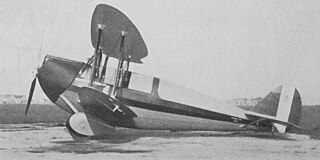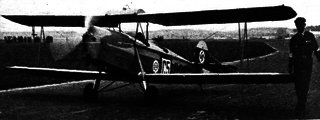Related Research Articles

The Handley Page Type G was a two-seat British biplane, designed by Handley Page that first flew in 1913. Only one was built.
The Surrey Flying Services AL.1 was a single-engined side-by-side two-seat training biplane, built at a UK flying club in 1929. Only one was built, but it was flying until the outbreak of war in 1939 and remains in storage.
The Perry Beadle T.1 was a single-seat, single engine biplane built and flown in the United Kingdom in 1913. In 1914 it flew with a more powerful engine and other modifications as the Perry Beadle T.2, which was acquired by the Royal Navy Air Service at the outbreak of World War I.

The Caproni Ca.125 was a single-engine, tandem two-seat, touring biplane built in Italy in 1933. It could be operated either as a landplane or seaplane.

The LFG Roland D.XV was a World War I German single seat fighter aircraft, ordered as a test-bed for engine comparisons. It was distinguished from earlier Roland biplane designs by the elimination of flying wires. Two later aircraft, also called LFG Roland D.XV, were completely different designs with slab sided fuselages.

The Schütte-Lanz G.I was a large, twin engine, pusher configuration, experimental biplane built in Germany early in World War I. Only one was completed.

The Albatros C.XIV was a German two seat, single engine, biplane fighter aircraft built in 1918. Only one was constructed.

The Albatros L.71 was a two-seat, single pusher engined biplane built in Germany in the 1920s.
The Siemens-Schuckert B was an unarmed German two seat reconnaissance biplane built early in World War I. A single example was delivered but soon lost.

The Gerner G II or Adler-Gerner G II was a German steel framed, low power biplane, intended both for sports and training in the early 1930. Over fifty were built for clubs and private owners.

The Caudron C.68 was a two-seat French training and touring aircraft, built in the early 1920s, which attracted interest at the time because of its simple and fast wing folding arrangement. Only a few were produced.

The Caudron C.67 was a simple single seat biplane with a low powered engine. It was built and flown in France in 1922.

The Caudron Type O was a French single seat air racing biplane first flown in 1914.
The Caudron Type B was a 1911 development of the earliest Caudron type, the Caudron Type A, with a nacelle style fuselage and more powerful engine. Initially an equal span biplane, it was modified into a sesquiplane.
The Caudron Type B Multiplace was a large French biplane designed to carry up to five passengers in a cross country time trial of 1912. It was destroyed early in the event.

The Caudron Type D was a French pre-World War I single seat, twin-boom tractor biplane, a close but slightly smaller relative of the two seat Caudron Type C. More than a dozen were completed, one exported to the United Kingdom, where they may also have been licence built, and three to China.

The Heinkel HD 20 was a twin engine, three seat German biplane built in 1926 for civil survey work.

The Skraba S.T.3 was a two-seat Polish biplane built in 1928. It was the first all-metal aircraft designed in Poland; only one was completed.

The Raab-Katzenstein RK.9 Grasmücke (Hedge-sparrow) was a 1920s German two-seat touring, advertising and training biplane. It was one of many designs from several countries aiming to provide low cost flying and was quite successful, with about twenty built.
The Bulté RB.1 was a Belgian training and touring biplane first flown in 1928. Five examples flew with clubs and with private owners in contests and rallies.
References
- 1 2 3 4 5 Kens, Karlheinz (2011). Historische Deutsche Flugzeug bis 1945 band 1 [Historic German Aircraft before 1945] (in German). Baden-Baden: Modellsport Verlag GMBH. pp. 92–97. ISBN 978-3-923142-39-2.